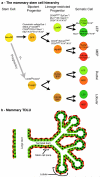Of microenvironments and mammary stem cells
- PMID: 17873346
- PMCID: PMC3004778
- DOI: 10.1007/s12015-007-0024-4
Of microenvironments and mammary stem cells
Abstract
In most adult tissues there reside pools of stem and progenitor cells inside specialized microenvironments referred to as niches. The niche protects the stem cells from inappropriate expansion and directs their critical functions. Thus guided, stem cells are able to maintain tissue homeostasis throughout the ebb and flow of metabolic and physical demands encountered over a lifetime. Indeed, a pool of stem cells maintains mammary gland structure throughout development, and responds to the physiological demands associated with pregnancy. This review discusses how stem cells were identified in both human and mouse mammary glands; each requiring different techniques that were determined by differing biological needs and ethical constraints. These studies together create a robust portrait of mammary gland biology and identify the location of the stem cell niche, elucidate a developmental hierarchy, and suggest how the niche might be manipulated for therapeutic benefit.
Figures

References
-
- Deome KB, Faulkin LJ, Jr., Bern HA, Blair PB. Development of mammary tumors from hyperplastic alveolar nodules transplanted into gland-free mammary fat pads of female C3H mice. Cancer Research. 1959;19:515–520. - PubMed
-
- Kordon EC, Smith GH. An entire functional mammary gland may comprise the progeny from a single cell. Development. 1998;125:1921–1930. - PubMed
-
- Tsai YC, Lu Y, Nichols PW, Zlotnikov G, Jones PA, Smith HS. Contiguous patches of normal human mammary epithelium derived from a single stem cell: Implications for breast carcinogenesis. Cancer Research. 1996;56:402–404. - PubMed
-
- Clarke RB, Spence K, Anderson E, Howell A, Okano H, Potten CS. A putative human breast stem cell population is enriched for steroid receptor-positive cells. Developmental Biology. 2005a;277:443–456. - PubMed
-
- Kang KS, Morita I, Cruz A, Jeon YJ, Trosko JE, Chang CC. Expression of estrogen receptors in a normal human breast epithelial cell type with luminal and stem cell characteristics and its neoplastically transformed cell lines. Carcinogenesis. 1997;18:251–257. - PubMed
Publication types
MeSH terms
Grants and funding
LinkOut - more resources
Full Text Sources
Other Literature Sources
Medical
